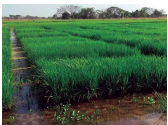Hybrid rice technology in Venezuela
Abstract
In the world from an economic point of view there are only two cultivated species of rice, Oryza sativa L. and Oryza glaberrima L. This cereal constitutes the main source of energy worldwide. In this regard, FAO 2015 estimates that to maintain the current rate of population growth, the annual world production of paddy rice in harvested area should increase from 162 to 164 million hectares from 2015 to 2030, while the yield of grains would go from 4.2 to 4.7 tons per hectare in the same period. Developing countries will represent approximately 70% of the growth in production until the year 2030. However, many Asian nations will not have new land to increase production and, therefore, the increased demand for rice must be sustained by increased grain yield among other factors.
Among the main contributions of genetic improvement to the crop worldwide are the dwarf or semi-dwarf varieties developed in the 60s, and secondly, the hybrid rice technology in the 70s, both in Asia. These innovations have had a significant impact on the increase in the sowing area and crop yield in the world.
The development of hybrid rice technology seeks to commercially exploit hybrid vigor or heterosis. The first works materialized in the 70s in China, under the coordination of scientist Yuan Longping, by the 80s, and the area cultivated with this technology had expanded to almost half of the rice area in China. The hybrid vigor defined as the superiority of the F1 hybrid over its parents or over the most productive parent and even over the conventional control variety most used commercially, constitute the concepts of parental heterosis, heterobelthiosis and standard heterosis, respectively, the latter being the most useful. from the practical point of view (Longping and Xi-Qin, 2001).
In this regard, Torres (2014) points out that rice hybrids have been a very beneficial technology from the economic point of view in Asia, mainly in China, in addition to allowing a very dynamic and competitive hybrid seed market. Thus, for 2008, the sowing area was 18.6 million hectares (63% of the total); the average yield of the hybrids was 30% higher than that of the conventional varieties, increasing production up to 44%.
References
Álvarez, R. M. Pérez, E. Reyes, O. Moreno, N. Delgado, G. Torrealba, M. Acevedo, W. Castrillo, M. Navas, M. Salazar, O. Torres, E. Torres, P. García y A. Pérez. 2008. Evaluación comparativa de híbridos y variedades de arroz en los Llanos Centrocidentales de Venezuela. Agronomía Tropical, 58(2): 101-110 pp.
FAO. 2015. Agricultura mundial: hacia los años 2015/2030, informe resumido. ftp://ftp.fao.org/docrep/fao/004/y3557S/y3557s00.pdf, en línea consultado 24/03/2016.
Fondo latinoamericano y del Caribe de arroz con Riego (FLAR). 2014. Comité técnico del FLAR para la zona tropical, comité de hibrido de arroz para América Latina (caso Venezuela). Villavicencio y Santa Rosa, departamento del Meta, Colombia del 31/08 al 06/09.
Fundación DANAC. 2014. Desarrollo de híbridos de arroz en Fundación Danac. Conexión DANAC, edición especial N° 19. San Javier, estado Yaracuy. septiembre.
Longping Y., F. Xin-Qin. 2001. Tecnología para la producción de híbridos de arroz. (http://www.fao.org/3/contents/ b9cdbd4b-f88d-5a42-9293-c39a8a58fd8c/v4730s00. htm#P-1_0, en línea consultado 22/03/2016).
Torres E. 2014. Desarrollo de híbridos de arroz para América Latina “Un desafío para la investigación en mejoramiento de arroz”. (http://www.aca.com.uy/ wp-content/uploads/2014/08/Desarrollo-de-Hibridosde-arroz.pdf, en línea consultado 22/03/2016).
Red de agro-meteorología del INIA, Estación Bancos de San Pedro, Calabozo estado Guárico. http:// www.inia.gov.ve/index.php/institucional-inia/redde-agrometeorologia-del-inia, en línea consultado 22/03/2016).


